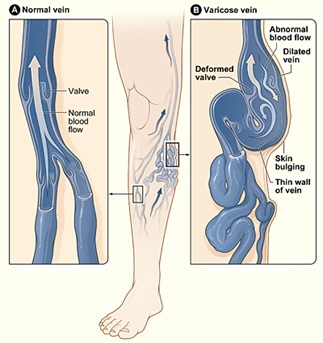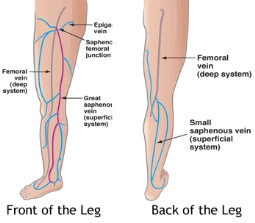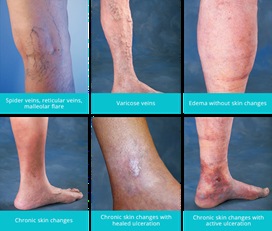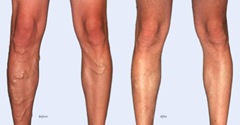To answer the question, what are varicose veins, we first need to address the anatomy of the veins of the lower extremity.
 Varicose Vein Anatomy
Varicose Vein Anatomy
There are two systems of veins of the lower extremity called the superficial veins, and the deep veins. In utero (before birth) it is the superficial veins that return the blood flow back to the heart, as the deep veins are not as of yet functional. Once we are born, the deep system takes over the role as the venous return to the heart, and the superficial system becomes expendable. As such, a normal superficial vein may be removed and not cause any consequences, and often is used to replace an artery in the heart , or even in the leg in bypass surgery.
How do veins return blood flow to the heart?
There are valves inside the veins, much like doors, that open to allow blood flow to pass, and then under normal circumstances will close and only allow the blood to flow in one direction. However, if these valves do not close, then the blood will flow down the leg, causing the vein wall to bulge. This bulging vein results in a varicose vein.
 Symptoms of Varicose Veins.
Symptoms of Varicose Veins.
As the amount of backwards blood flow increases, symptoms will develop. The symtpoms of varicose veins include: swelling of the leg, heaviness, tiredness, and aches and pain. Often an itchy sensation will occur. Addtionally, as the blood pools, this will allow blood to seep out of the vein wall causing a skin reaction, ankle swelling, brown discoloration, and eventually ulcers. The most increased pressure is at the ankle as it is the furthest distance from the heart and exerting the most gravity when standing.
Treatment for Varicose Veins.
Once these symptoms develop, action is needed to prevent irreparable damage. At first, a compression stocking should be used, which will prevent the pooling of vein blood flow, and by pumping the blood flow more rapidly out of the leg. However, this is not a good long term solution, and the best option would be to rid the body of the abnormal vein.
Many ask, “don’t i need these veins?” Clearly not, as they are no longer participating in normal blood flow return, and could never be used as an arterial substitute.
The options that exist today have changed the management protocol, and most cases can be managed by minimally invasive procedures including laser ablation, which will seal the vein internally without the need for vein removal. For more details regarding laser ablation of varicose and spider veins please see previous blogs.



